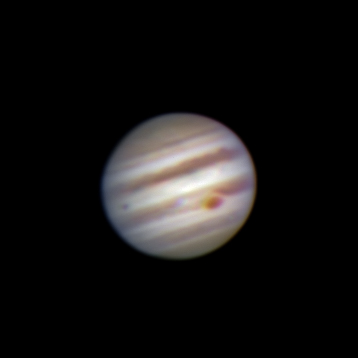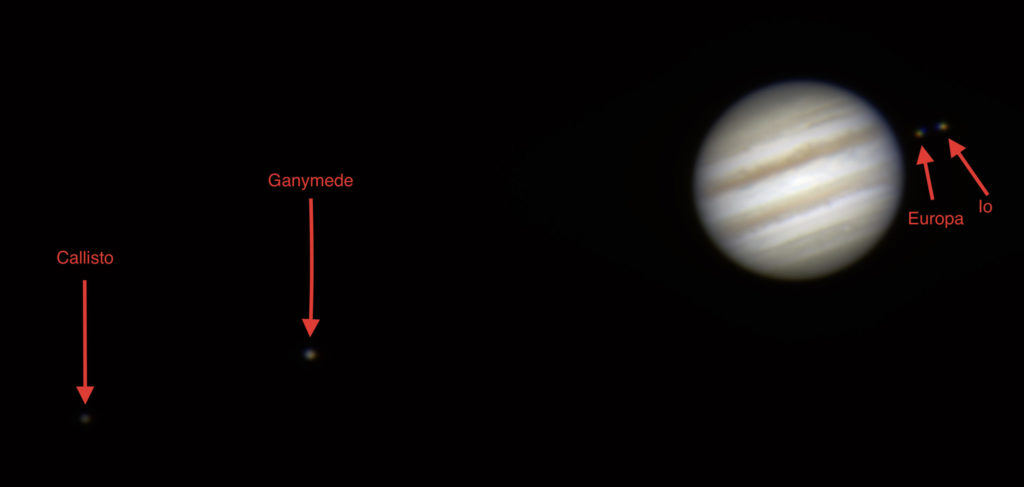
Jupiter, imaged with the Large Monolithic Imager on the Lowell Discovery Telescope, Credit LLama/Lowell Obs/NSF
From the Arizona Daily Sun, October 2, 2021
12 facts about Jupiter, the king of the planets
Jupiter continues to shine brightly in the eastern skies just after sunset. Here are a dozen fun facts about the king of the planets:
• Jupiter is the largest planet in the solar system. It contains twice the mass of all the other planets combined. About 1,300 Earths could fit inside Jupiter and one would have to line up about 11 Earths to equal one Jupiter diameter. If Jupiter was only 80 times more massive, nuclear fusion would have occurred in its core and it would be a star rather than a planet.
• Jupiter is one of the four gas giants, along with Saturn, Uranus and Neptune. These planets, also known as the Jovian planets (after Jupiter, which was named after the Roman king of the gods, Jove) are the largest in the solar system and consist mostly of gases such as hydrogen and helium.
• Jupiter has rings. In fact, all of the gas giants have them. Contrary to Saturn’s grand system of bright, icy rings, Jupiter’s are made of dust and very faint.
• Jupiter is one of five planets visible to the unaided eye, along with Mercury, Venus, Mars and Saturn. It was thus visible to ancient observers, well before telescopes came along. Jupiter’s earliest recorded observations date back to Babylonian times of the 7th – 8th centuries B.C.
• Jupiter has the shortest day of any of the planets, lasting only 9 hours and 55 minutes. Its fast spinning causes it to flatten a bit, giving it a slightly oblate shape.

• Jupiter has 82 confirmed and named moons, though scientists predict many more exist. Galileo discovered the first four in 1610, the first time anyone conclusively proved celestial bodies can orbit something besides Earth. This was important evidence supporting a sun-centered, rather than Earth-centered, solar system. These four moons — Io, Europa, Ganymede, Callisto — are nicknamed the Galilean satellites and comprise some of the largest moons in the solar system. Ganymede is the largest of all solar system satellites and is even bigger than Mercury and Pluto.
• Galileo developed a method for determining longitude using Jupiter’s four large moons. Galileo lived in the days before an accurate method of calculating longitude was known. After observing his newly discovered quartet of Jupiter’s moons for a year, he calculated their orbits and predicted the times at which Jupiter would eclipse them. His predictions were accurate enough that they could be used to set a watch, the key to determining longitude. To view the satellites, Galileo designed a special helmet which he called a celatone. This headgear had two eyeholes; one was an empty hole through which the observer located Jupiter; once this was accomplished, the observer would then view the satellites through a telescope that covered the other eyehole. This was difficult, especially when attempted on a rocking boat at sea. Moreover, this method could be used only at night, and even then only on clear evenings during the seasons in which Jupiter and its moons were visible. Despite these obstacles, this method of determining longitude was used for years, albeit primarily on land.https://8f36156cd0b1ee89074f1a4ab24ed574.safeframe.googlesyndication.com/safeframe/1-0-38/html/container.html
• 17th–century astronomers calculated the speed of light by studying Jupiter’s four large moons. In 1676, the Danish astronomer Ole Roemer observed that the expected time of Jupiter’s satellite eclipses changed, depending on Earth’s proximity to Jupiter and its family of satellites. When Earth reached its closest point, the eclipses occurred ahead of schedule; when Earth was more distant, the eclipses occurred behind schedule. Roemer was able to determine a reasonably fair approximation of the modern accepted value of about 186,000 miles per second. This is about 27,000 times faster than the Saturn V rocket that propelled astronauts to the Moon and 25 million times the fastest human, Usain Bolt.

• A giant storm, called the Great Red Spot, measures two to three times the size of Earth. Italian astronomer Giovanni Cassini first identified this anticyclone in 1665, and astronomers have been studying it ever since.
• Fragments of Comet Shoemaker-Levy 9 blasted into Jupiter in 1994. Astronomers from around the world witnessed this event through telescopes, marking the first time humans observed such a collision of solar system bodies. Two of the more interested observers were Flagstaff scientists Gene and Carolyn Shoemaker, who with Canadian-born astronomer David Levy discovered the comet in 1993.
• Jupiter features the strongest magnetic field in the solar system. Thought to be generated by electric currents within Jupiter’s liquid outer core, it is responsible for enormous auroral displays that can create hundreds of times more energy than Earth’s northern and southern lights.https://8f36156cd0b1ee89074f1a4ab24ed574.safeframe.googlesyndication.com/safeframe/1-0-38/html/container.html
• Jupiter is the destination for David Bowman, Frank Poole, and computer HAL in the movie 2001: A Space Odyssey. The book, written by Arthur C. Clarke at the same time the movie was being made, targets Saturn, rather than Jupiter, as the destination.